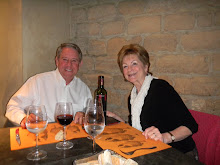Friday morning we said adieu to Sarlat and proceeded toward Collanges la Rouge, another village I didn’t want Sandy and Bob to miss, although I was in silent fear and dread that we would end up on yet another mountainous climb. But it was easy to get to (relatively) and we had a pleasant stroll around the tiny village.
The buildings in Collanges are all built of red limestone, thus the La Rouge part of its name. I think the word Collanges means round turrets, because many of the buildings have round almost castle-like forms, although in miniature. Collanges la Rouge is also a goose center and along with open fields of free-range geese, they have a demonstration of “gavage” which is the system of force-feeding to fatten the goose livers in order to produce the finest foie gras. Happily for us, the gavage was not scheduled during our brief visit, so we missed it. Bob and Sandy were understandably horrified at the very thought, and in fact there is a movement afoot in France to eliminate the practice, but gastronomy always takes precedence and so far the animal rights folks have not prevailed.
We did see the gavage a number of years ago and as I remember it, the geese are led single file from the field into a barn where one by one they enter a chute type thing which lifts their necks and pours grain down their throats to the point of capacity. They don’t complain and in fact seem quite content. Then they go back to romp in the fields of green. When properly fattened however, they meet the fate for which they were destined and thus fatten the wallets of the many foie gras merchants in the region. Thus, the food chain continues through the millennia….
Mercifully saved from having to witness the gavage, we moved on to our next stop, Oradour sur Glanes outside of
Oradour was a small but prosperous village during the Second World War which managed to survive the devastation that was all around them. However, on June 10, 1944—the war actually being over for several days—a troop of Nazis entered the town on tanks and after toying with the villagers for some hours and promising them no harm, they massacred the entire town, all 642 of them, shooting the men and burning their bodies and locking the women and children in the church and setting fire to it. It was an atrocity of such major proportions that when Charles de Gaulle heard what had happened, he ordered the charred remains of the village to be left just as it was for posterity in order to witness war in all of its horror. Now it is a shrine called the Village of the Martyrs.
You approach the village down a long entrance path into an underground museum which tells the story through photos and films. After that, you walk out the back to the village which is just as it was after the massacre. Burned out cars sit in their courtyards, sewing machines, overturned bed frames and iron tubs sit rusting just as they were. Of course there are no human remains, but on many of the doorways, there are names like J. Michel, coiffeur (hairdresser), or M. Gardot, café, or G. Marieu, boucher (butcher). It is so real that you can imagine the village alive with children and commerce. In the church there is a plaque which commemorates the village priest who lost his life trying to protect the children. And in the cemetery, which of course pre-dates the massacre and has residents dating from way before the event, is dotted with gravestones and shrines in memory of those who lost their lives that day. Some whole families are enshrined in a single grave. And then there are at least three large crypts which contain the remains of those unidentified, because the Nazis actually came back a couple of days after the murders and burned whatever bodies that weren’t already obliterated.
A few people actually survived, only 14 I think, mostly because they were out of the village on errands, and it is through them that the details have been put together.

No comments:
Post a Comment